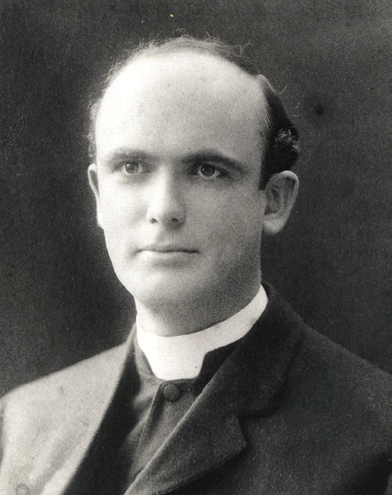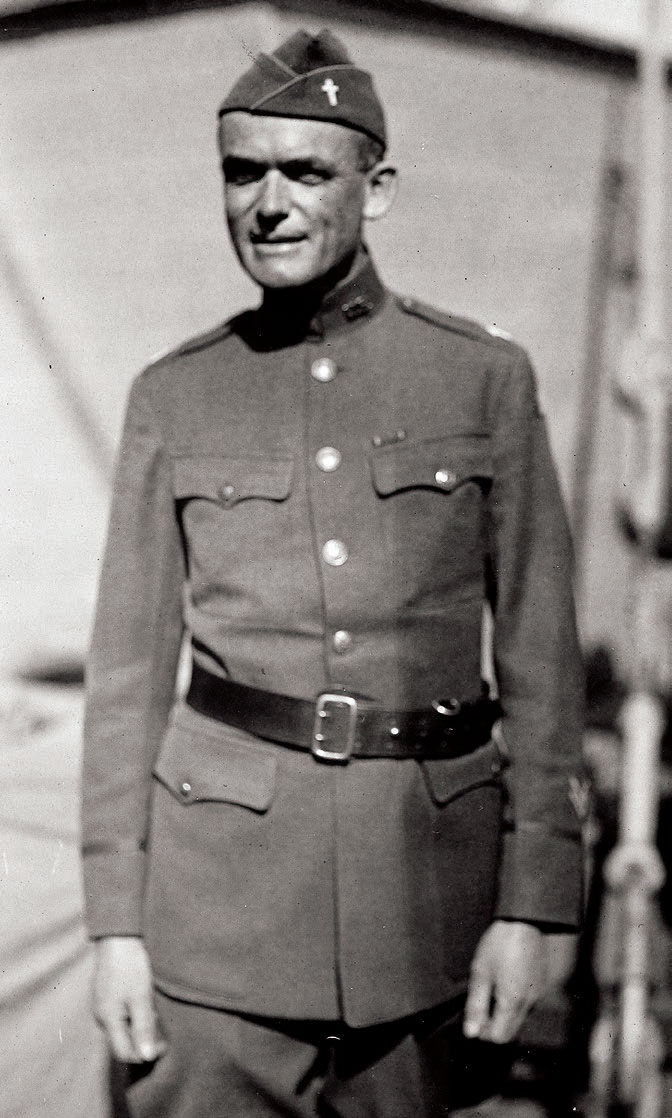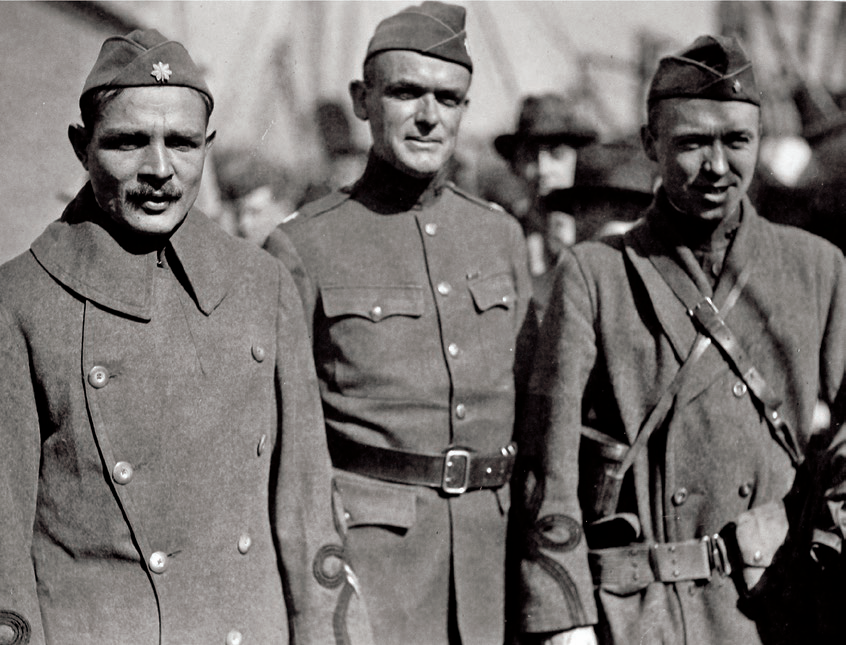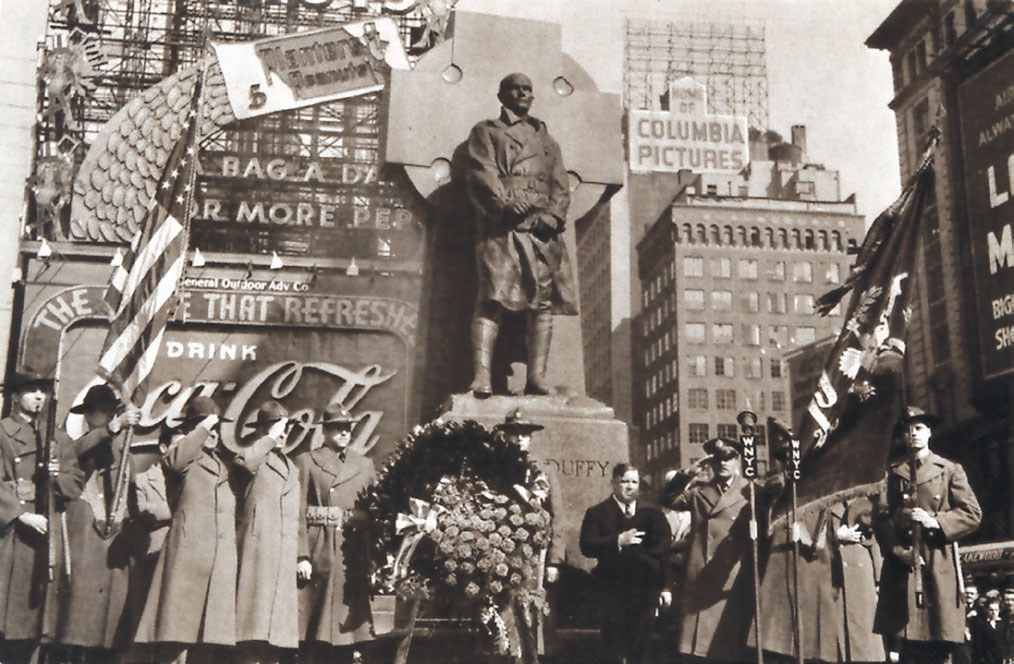WWI’s ‘Fighting Chaplain’ Wielded Prayer
WWI’s ‘Fighting Chaplain’ Wielded Prayer
By Daniel J. Demers

- Cobourg Public Library, Ontario

The Rev. Francis Patrick Duffy is perhaps the best-known and most highly decorated chaplain of World War I. The Catholic priest and soldier served with the New York Army National Guard’s “Fighting 69th” Infantry Regiment, putting himself into the thick of battle to minister to the injured and dying. As one young officer who served with Duffy in the French trenches noted, Duffy “forgot personal danger to serve his lads.”
Duffy was born in Canada in 1871. Shortly after graduating from Toronto’s St. Michael’s College, he immigrated to New York City and taught at what is now Xavier High School before pursuing graduate studies at Catholic University in Washington, D.C. He was ordained in 1896.
His first military assignment was during the Spanish-American War. Duffy volunteered to serve as post chaplain at Camp Wikoff, located on Montauk Point, N.Y., because an outbreak of typhoid fever required a chaplain to tend to the spiritual needs of returning Catholic soldiers. One historical account noted the duty was “dangerous and unglamorous,” and Duffy “did not have a lot of competition for the slot.” In fact, Duffy himself contracted the disease.
In 1898, at the conclusion of the war, Duffy was one of the first soldiers to welcome Col. Theodore Roosevelt and his Rough Riders home to New York.
Considered an Innovator
As a parish priest, Duffy was considered an innovator. In 1914 when he was pastor of New York City’s Church of Our Savior, he established a nursery, or what was then called “a storeroom,” to care for babies while their mothers attended church services, according to an article in The Washington Herald. That same year, Duffy, now a first lieutenant, was appointed chaplain to the New York Army National Guard’s 69th Infantry Regiment, which was predominantly composed of Irish-Catholics.
In 1916, the unit was activated and deployed along the Mexican-American border to protect border towns from Mexican revolutionaries—especially Pancho Villa—who crossed into America and attacked Columbus, N.M. A year later, the regiment was called to duty as the 165th Infantry Regiment for service in World War I.
| A Catholic priest, Francis Patrick Duffy served as an Army chaplain during the Spanish-American War and World War I. |
Within weeks of the U.S. declaring war against the Central Powers, Duffy was prominently mentioned in American newspapers. They reported that he was recruiting Catholics to join regiments that had Catholic chaplains. In a 1917 article in the Kentucky Irish American, Duffy expressed concern about a “haphazard distribution of recruits, without regard to religious” consideration, fearing “Catholic youths, torn entirely from Catholic surroundings, will drift away from the church.”
A year later, the New York Tribune published a lengthy story extolling Duffy as a “heroic figure in the eyes of his men.” One witness to his ministering said Duffy “appears to lead a charmed life” and when cautioned to be careful, he responds, “No Hun bullet can touch me.” The article also said Duffy had given each soldier in the 69th a “metal cross about his neck.” Just before the regiment left for France, someone gave Duffy several hundred dollars, and he used that money to buy the crosses.
‘I Give Them Hell First’
The Tribune article also said to facilitate soldiers’ confessions, Duffy had cards printed that contained French and English translations of various transgressions. He soon began to notice that a lot of soldiers preferred to go to French priests for confession rather than to Duffy. “All the French priests give is absolution,” Duffy said. “I give them hell first.”
First Lt. George Benz, who served with Duffy in the French trenches, recalled seeing the priest hearing the confession of “a little Irish private [while] the moan of the shells whizzing through the air furnished the doleful [background] music. … When men were facing and some meeting death every few minutes, you’d find Father Duffy. He was more than a father confessor to the men—he was their friend, their pal.”
Benz also recalled seeing him “bending over a man who was gassed and lay in the mud struggling for air, frothing at the mouth. As the priest’s hands closed over the fingers of the dying soldier, into the eyes soon to be closed to all worldly strife came a look of peace, of that great faith that sends a man smiling before his Maker.”
Fellow chaplain Percy Edrop, who served with Duffy, wrote: “There was something in the manner of the man that bespoke his religious conviction. There was something in his frank smile and in his serenity that made one feel he would undergo any dangers, endure any hardships, give his life—if he could be of service.”
He remembered Duffy’s exploits in one 1918 battle: “Father Duffy spent the whole day on the battlefield. He bore men to shelter under a heavy machine gun fire. He cheered them by word and by example. He brought them comforts. He thrilled them by his disregard of danger.”
During the war, the regiment fought in nine battles. More than 640 men died and another 2,000 were wounded. Duffy received the Distinguished Service Cross and Distinguished Service Medal from the U.S., and the Croix de Guerre and Légion d’honneur decorations from France. He retired as a lieutenant colonel.

- The Rev. Francis Patrick Duffy, center, returns home with the 165th Infantry Regiment after World War I.
The Soldiers’ Hero
After the war, Edrop observed that Duffy was “the soldiers’ hero” who had “caught the popular fancy.” He “treated his job like a huge parish” and “took an interest in the families of all the men. He saw that the unemployed found work. He made the unruly behave.” When men suffered from homesickness, he “went among them saying a cheery word here and there. He was at their service” and “succeeded in imparting to them his own buoyancy.”
“He came back [from the war] with the affection of every man in the outfit,” Edrop said. “Most of them, he knew by name.”
In May 1919, about 25,000 people turned out in the rain to honor Duffy in a parade and ceremony in the Bronx, N.Y., as “a token of the honor and affection” in which he was held. Duffy had not wanted all of this attention, but local authorities and the Catholic hierarchy insisted he participate.
In December 1921, Duffy was once again feted by thousands at New York’s legendary Hippodrome Theater. It was a joyous party to celebrate his 25th anniversary as a priest. He was forced to sit blushing “to the top of his glistening bald head” as U.S. senators, the archbishop and other orators honored the “fighting chaplain.”
Duffy served the remainder of his life as pastor of Holy Cross Church in New York City near Times Square. He died in 1932 at the age of 62 and in 1937, a massive statue of him was unveiled at the north end of Manhattan’s Times Square.
In 1940, his inspiring life was honored once again when Warner Bros. released the film The Fighting 69th. Actor Pat O’Brien portrayed Duffy as the chaplain who attempts to reform a misfit private played by James Cagney.
A statue of the Rev. Francis Patrick Duffy was erected in New York City’s Times Square after his death in 1932.
Daniel J. Demers, who served in the Nevada National Guard in the 1970s, researches and writes about 19th- and 20th-century events and personalities. He also owns and operates a sports bar in Guerneville, Calif. He holds a bachelor’s degree from George Washington University, Washington, D.C., and an MBA from Chapman University, Calif.
This article originally appeared in ARMY magazine, Vol. 67, No. 3, March 2017.
Copyright 2017 by the Association of the United States Army, all rights reserved



